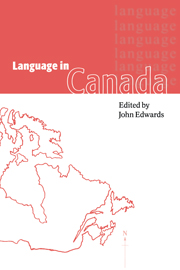Book contents
- Frontmatter
- Contents
- List of figures
- List of maps
- List of tables
- Notes on contributors
- 1 Canada
- Introduction
- 1 The foundations
- 2 The fading Canadian duality
- 3 Official bilingualism: from the 1960s to the 1990s
- 4 Official multiculturalism
- 5 Language in education: bridging educational policy and social psychological research
- 6 Aboriginal languages: history
- 7 Aboriginal languages: current status
- 8 French: Canadian varieties
- 9 French in Quebec
- 10 French in New Brunswick
- 11 French outside New Brunswick and Quebec
- 12 English: Canadian varieties
- 13 English Quebec
- 14 The teaching of international languages
- 15 French immersion in Canada
- 16 Language in Newfoundland
- 17 Language in Prince Edward Island
- 18 Language in Nova Scotia
- 19 Language in New Brunswick
- 20 Language in Quebec: aboriginal and heritage varieties
- 21 Language in Ontario
- 22 Language in Manitoba
- 23 Language in Saskatchewan: Anglo-hegemony maintained
- 24 Language in Alberta: unilingualism in practice
- 25 Language in British Columbia
- 26 Language in the Northwest Territories and the Yukon Territory
- Index of names
- Index of language families, languages, dialects
- Index of subjects
24 - Language in Alberta: unilingualism in practice
Published online by Cambridge University Press: 18 February 2010
- Frontmatter
- Contents
- List of figures
- List of maps
- List of tables
- Notes on contributors
- 1 Canada
- Introduction
- 1 The foundations
- 2 The fading Canadian duality
- 3 Official bilingualism: from the 1960s to the 1990s
- 4 Official multiculturalism
- 5 Language in education: bridging educational policy and social psychological research
- 6 Aboriginal languages: history
- 7 Aboriginal languages: current status
- 8 French: Canadian varieties
- 9 French in Quebec
- 10 French in New Brunswick
- 11 French outside New Brunswick and Quebec
- 12 English: Canadian varieties
- 13 English Quebec
- 14 The teaching of international languages
- 15 French immersion in Canada
- 16 Language in Newfoundland
- 17 Language in Prince Edward Island
- 18 Language in Nova Scotia
- 19 Language in New Brunswick
- 20 Language in Quebec: aboriginal and heritage varieties
- 21 Language in Ontario
- 22 Language in Manitoba
- 23 Language in Saskatchewan: Anglo-hegemony maintained
- 24 Language in Alberta: unilingualism in practice
- 25 Language in British Columbia
- 26 Language in the Northwest Territories and the Yukon Territory
- Index of names
- Index of language families, languages, dialects
- Index of subjects
Summary
INTRODUCTION
Coureurs de bois, natives and missionaries constituted the initial Albertan population and most non-English European minority languages lacked prestige as settlers came to Alberta. Moreover, pressure was exerted on the immigrant settlers to abandon their culture and linguistic heritage. While early settlers existed in heterogeneous linguistic, religious and ethnic communities, they enjoyed the freedom to use their mother tongue in their home and with friends and neighbours. Nevertheless, doing business with surrounding farmers and businessmen required the use of the lingua franca of the area – English. As Prokop (1990) points out, the economic success of ‘King Wheat’ necessitated a greater openness to the world and to the anglophone culture. The identification with, and support of, the political system also played an important role in the anglicization of immigrants.
During the first three decades of the twentieth century, the francophone presence was substantially weakened as other western European immigrants arrived. As Alberta became more urban and industrialized, it further linked itself to the anglo world. Still, the role of French in Alberta has a unique and important role in the language debate now taking place. Any attempt to treat the French as a special group in Alberta has long been resisted by provincial authorities, supported by its residents.
- Type
- Chapter
- Information
- Language in Canada , pp. 442 - 459Publisher: Cambridge University PressPrint publication year: 1998



